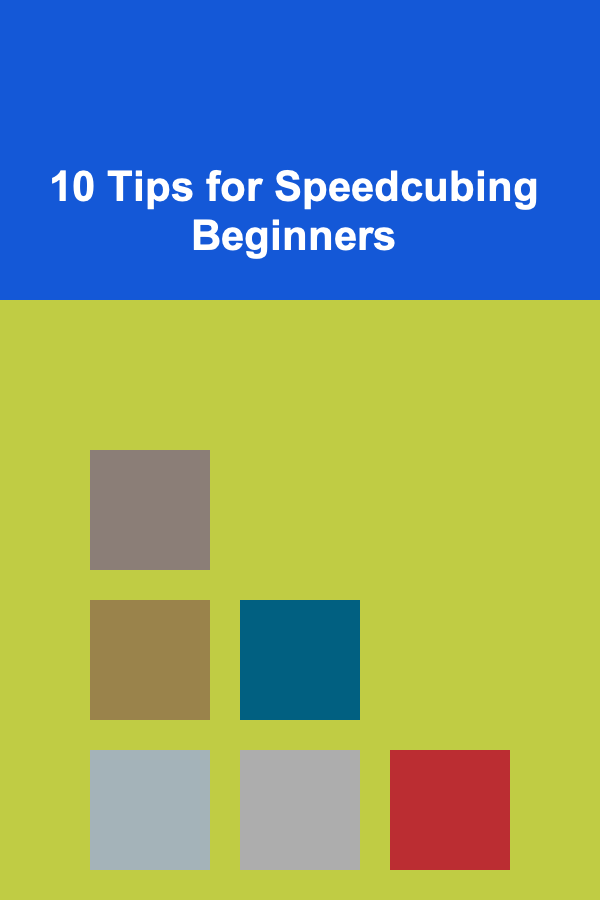
10 Tips for Speedcubing Beginners
ebook include PDF & Audio bundle (Micro Guide)
$12.99$10.99
Limited Time Offer! Order within the next:

Speedcubing is a fascinating and challenging hobby that involves solving the Rubik's Cube (and other similar puzzles) as quickly as possible. Whether you've just picked up a cube for the first time or have been working on improving your solving times, becoming a speedcuber requires dedication, patience, and the right techniques. In this article, we'll explore ten essential tips that will help you improve your speedcubing skills, providing a roadmap for beginners who are eager to make progress and increase their solving speed.
Master the Basics
a. Learn the Notation
Before you can speedcube effectively, it's essential to learn the notation used to describe cube moves. In speedcubing, the Rubik's Cube is manipulated using specific letter-based notation. Each face of the cube is represented by a letter: U (Up), D (Down), L (Left), R (Right), F (Front), and B (Back). A move is typically indicated by the letter, with a counter-clockwise move often denoted by an apostrophe (e.g., U' for an up move counter-clockwise).
Understanding notation will help you follow tutorials, algorithms, and communicate effectively with the cubing community.
b. Know the Basics of Cube Orientation
The first thing you need to get comfortable with is holding the cube correctly and understanding its orientation. While solving, your goal is to manipulate the cube in such a way that the pieces align properly to solve it in the fewest moves. Practice turning the layers and getting used to how the pieces move, especially the center pieces, which determine the orientation of the cube.
Start with the Layer-by-Layer Method
The Layer-by-Layer (LBL) method is one of the most popular solving techniques for beginners and is often the best place to start. This method involves solving the cube in three layers: the first layer (usually starting with the white face), the middle layer, and the last layer (the top face).
a. Solve the First Layer
The first step in LBL is solving the first layer, which is typically the white face. Focus on solving the white cross first (the edges), ensuring that the white center pieces match the edge colors correctly. Then, solve the white corner pieces so that the entire first layer is complete.
b. Complete the Middle Layer
After solving the first layer, you move on to solving the middle layer. This involves positioning the edge pieces in the correct places. Use algorithms designed to move the middle layer edge pieces without disturbing the already solved first layer.
c. Solve the Last Layer
Finally, solve the last layer using a series of algorithms. The goal is to orient and permute the pieces on the top layer to solve the cube. This step involves various algorithms to move pieces into their correct positions, while avoiding disrupting the rest of the cube.
Learn Basic Algorithms
Speedcubing relies heavily on algorithms---sequences of moves that allow you to manipulate the cube in a specific way. As a beginner, you should start by learning some of the basic algorithms used in the Layer-by-Layer method.
a. Memorize Key Algorithms
Start with the following essential algorithms:
- The white cross algorithm: Learn how to move the edge pieces into place without disturbing the solved white corners.
- The middle layer edge algorithm: Focus on algorithms for inserting the edge pieces into the middle layer.
- The last layer algorithms: Learn algorithms to orient and permute the pieces in the last layer.
b. Practice Algorithms Repeatedly
It's important to practice these algorithms until they become second nature. Speedcubing is all about muscle memory, and the more you practice these algorithms, the faster and more fluid your solves will become.
Work on Your Finger Tricks
One of the key elements that separate beginners from experienced speedcubers is finger tricks. Speedcubing is not just about knowing the algorithms; it's also about executing them efficiently with quick and fluid movements. Finger tricks involve using specific fingers to execute moves more quickly, reducing the time it takes to turn the cube.
a. Focus on Efficient Turns
Instead of using your whole hand to turn the layers of the cube, use your fingers to make small, efficient movements. For example, you can use your index finger and thumb to turn the front face, and your other fingers to manipulate the side faces. This will allow you to perform the moves more quickly and with less effort.
b. Develop Finger Dexterity
Practicing with different finger tricks and working on your dexterity will help you increase your overall solving speed. Start slow, focusing on making each move as smooth and controlled as possible. As you improve, you'll be able to perform the moves faster.
Practice Your Cross
The first step in most solving methods is creating the cross on the first layer. It's vital to get the cross solved as quickly as possible because it sets the foundation for solving the rest of the cube. As a beginner, you may focus on solving the cross one piece at a time, but as you progress, aim to solve the entire cross in just a few moves.
a. Develop an Efficient Cross Method
Try to plan the cross pieces before starting the solve. This will allow you to execute the cross much faster. With practice, you'll be able to recognize the best move sequences to solve the cross in minimal steps.
b. Learn to Pair Edges and Corners Simultaneously
Advanced speedcubers often pair the first layer's edges and corners together as they solve the cross, allowing for a faster transition to the next layer. This is a crucial step for improving your solving time and should be practiced as you gain experience.
Use a Good Cube
While it may not be the most important factor for beginners, using a quality cube can significantly affect your speedcubing experience. Cheap cubes can be stiff, slow, and difficult to maneuver, which can lead to frustration and hinder your progress.
a. Choose a Cube That Suits You
There are many speedcubes on the market, and finding one that suits your style of solving is essential. Popular brands like GAN, MoYu, and QiYi offer a variety of cubes with different characteristics. Look for a cube that has smooth turns, adjustable tension, and good corner cutting (the ability to turn past 45 degrees).
b. Maintain Your Cube
To keep your cube in optimal condition, regularly clean it and lubricate the moving parts. This will ensure that your cube continues to perform well and reduces the risk of it becoming sluggish or stiff over time.
Learn Advanced Techniques Over Time
Once you've mastered the basics and are able to solve the cube consistently, it's time to start learning more advanced techniques that can improve your solving speed.
a. Understand F2L (First Two Layers)
One of the most important advanced techniques is F2L, which stands for First Two Layers. This method involves pairing up the corner and edge pieces of the first two layers and inserting them together, rather than solving them individually. This reduces the number of moves required and is essential for improving your solving time.
b. Learn OLL and PLL
OLL (Orientation of the Last Layer) and PLL (Permutation of the Last Layer) are methods that help you solve the last layer more efficiently. OLL involves orienting the pieces so that the top face is the same color, while PLL involves permuting the pieces into their correct positions.
Learning these techniques will drastically improve your solve times and make you more efficient in solving the Rubik's Cube.
Focus on Solving Efficiency
As you progress, you'll realize that solving the cube faster isn't just about learning new algorithms---it's about making each move count. Focus on minimizing the number of moves needed to solve the cube.
a. Minimize Unnecessary Turns
Avoid making unnecessary turns or rotations of the cube. For example, when positioning a piece, try to use as few moves as possible to get the piece into place.
b. Plan Ahead
Advanced cubers often plan their moves ahead of time. As you improve, try to look ahead while solving each layer. This will help you prepare for the next steps and solve the cube more efficiently.
Stay Consistent with Practice
Speedcubing, like any other skill, requires consistent practice. The more time you invest in practicing, the more natural solving the cube will become.
a. Set a Practice Routine
Create a consistent practice schedule. Dedicate time each day to solving the cube, whether it's focused on solving with a specific method, practicing algorithms, or improving your finger tricks.
b. Track Your Progress
Keep track of your solving times and note any improvements. Over time, you'll see a significant decrease in your solving times, which will motivate you to continue practicing.
Be Patient and Have Fun
Speedcubing is a journey, not a destination. While it can be frustrating at times, especially when you hit a plateau, remember that improvement comes with time and effort.
a. Celebrate Small Wins
Don't get discouraged if you don't see drastic improvements immediately. Celebrate small victories, whether it's solving the cube a little faster or mastering a new technique. These incremental improvements will keep you motivated.
b. Enjoy the Process
At the end of the day, speedcubing is a fun and rewarding hobby. Enjoy the process of learning and improving, and don't put too much pressure on yourself to achieve perfect times right away. Embrace the challenge, and let the joy of solving the cube drive you forward.
Becoming a skilled speedcuber requires time, dedication, and an understanding of the techniques and strategies that can help you improve your solving times. By mastering the basics, practicing consistently, and focusing on improving your finger tricks, algorithms, and efficiency, you can make significant progress in your speedcubing journey. Remember to be patient, celebrate small victories, and most importantly, have fun!
Reading More From Our Other Websites
- [Organization Tip 101] How to Organize Your Receipts for Easy Budgeting
- [Home Space Saving 101] How to Decline Small Spaces and Make the Most of Your Home
- [Organization Tip 101] How to Create Templates for Repetitive Tasks in a Virtual Workspace
- [Home Holiday Decoration 101] How to Create a Holiday Decorating Schedule
- [Home Staging 101] How to Gather Home Staging Inspiration from Unexpected Sources
- [Home Party Planning 101] How to Determine When Party Rental Equipment is Essential vs. Optional
- [Personal Investment 101] How to Protect Your Investments with Hedging Strategies
- [Home Staging 101] How to Stage Your Kitchen to Highlight Its Best Features
- [Tie-Dyeing Tip 101] Best Strategies for Marketing Handmade Tie‑Dye Products on Etsy in 2025
- [Sewing Tip 101] Best Vintage Sewing Patterns for 1920s Flapper Dresses

Beginner's Guide to DIY Clothing Alterations and Repairs for a Perfect Fit
Read More
Building Passive Income Streams Through Deep Learning Models
Read More
How to Create a Stylish Guest Room During Your Home Renovation
Read More
How to Leverage Real Estate Investment Trusts (REITs) for Passive Income
Read More
The Power of Presence: Being Fully There for Your Loved Ones
Read More
10 Tips for Building a Grocery List Generator That Actually Saves You Money
Read MoreOther Products

Beginner's Guide to DIY Clothing Alterations and Repairs for a Perfect Fit
Read More
Building Passive Income Streams Through Deep Learning Models
Read More
How to Create a Stylish Guest Room During Your Home Renovation
Read More
How to Leverage Real Estate Investment Trusts (REITs) for Passive Income
Read More
The Power of Presence: Being Fully There for Your Loved Ones
Read More